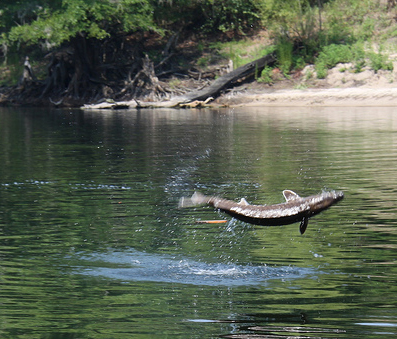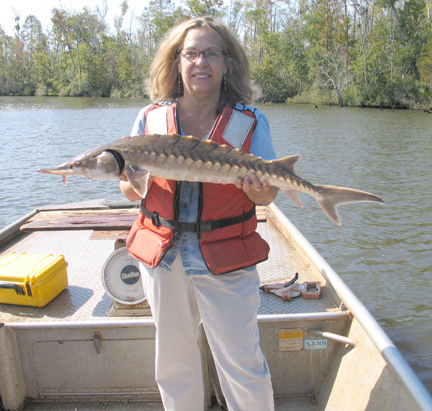Note: This story is from the Walton Outdoors’ archives. It was originally published in 2008. To view an up to date report of Gulf Sturgeon from 2022, click here: https://media.fisheries.noaa.gov/2022-06/Gulf%20sturgeon%205-yr%20review_20220601_signed.pdf
It’s not often one gets a chance to encounter a prehistoric creature. So when the opportunity arose to meet a fish with an ancestry that dates back 200 million years, well, I couldn’t pass. Through Nov. 7, 2008, the Panama City Field Office of the U. S. Fish & Wildlife Service conducted a Gulf sturgeon fish population census on the Choctawhatchee River.

I contacted Frank Parauka, Fishery Biologist with the FWS, and he was gracious enough to allow me to tag along on a tagging. I arrived at the Bunker Creek base camp about an hour before the first net check. The nets had been cast earlier in the morning and by 9:30; it was time for the first inspection. Along with Brad Smith, a biologist with the Audubon Coastal Bird Conservation Program; Bud Casey, a volunteer from Freeport; Frank and I set out on the research boat.
A section of the Choctawhatchee River was blocked with 4-5 nets, spanning across the river and placed about every 150 ft. The nets are checked every two hours for the sturgeon, and then taken up, after the last check in the evening.
The first three nets checked, no sturgeon. The nets were however, congested with jellyfish. Surprising to me that the jellyfish are found so far north up river. The jellies wreaked havoc on Frank and Bud’s footing as the slippery creatures fell unto the bow of the boat as they pulled the nets in.
Then the fourth net checked, BINGO! We’ve got a juvenile sturgeon!
The fish was pulled in and put into a live well on the Johnboat as Frank and Bud prepared the scale and the tagging equipment.
The fish was weighed, measured and tagged with a small plastic strip that was imprinted with a number for recordkeeping. A remote transmitter tag (similar to the chips we put in our cats and dogs) was attached to monitor the fish once it returns to the Gulf.
Then… it came time for my personal encounter.
“Are you ready, Lori?” Frank quipped. I put my arms out willingly, and held the fish as Brad snapped a picture. “Wow, this guy is kind of slimy,” I said.
Brad told me the slimy feeling was from the fish triggering a natural defense mechanism that secretes from its skin. “Oh!… I blurted squeamishly.” “I think he’s ready to get back into the river!”
I was in awe of how remarkable this creature looked and felt; the boney plates along its body, sculpted in curved ridges. It had a creamy, almost pinkish hue to it. With a mouth that was underneath, similar to a catfish, its eyes looking downward, and its pointed snout, with sensor barbs sticking out like and old man’s whiskers, the sturgeon appeared valiant in a peculiar sort of way.
Once again, I was amazed by the biodiversity of our own back yard.
Thanks guys! I had a great time, and a wonderful learning experience. I couldn’t think of a better way to spend a beautiful October morning.
Facts about Gulf Sturgeon
• As of Oct. 20, 2008 the current study on the Choctawhatchee River has tagged and released 75 sturgeon, the largest weighing in at 130 lbs.
• Sturgeon migrate up the Choctawhatchee River as far north as Alabama to spawn.
• There are roughly 2,000-3,000 sturgeon in the Choctawhatchee River; second in numbers only to the Suwannee River.
• At the end of the spawning season, the fish migrate to the Gulf of Mexico for the winter months; staying near the coastline, in an area that spans from Louisiana east to the Suwannee River.
• It takes up to 15 years for a sturgeon to mature, with the females spawning only once every 3-5 years; and generally returning to spawn in the same river. Sturgeon have been know to live up to 70 years.
• Gulf sturgeon (Acipenser oxyrinchus desotoi), were on the verge of extinction until they became a federally threatened species in 1991.
Lori Ceier is the publisher of waltonoutdoors.com, and can be reached via email at info@waltonoutdoors.com

